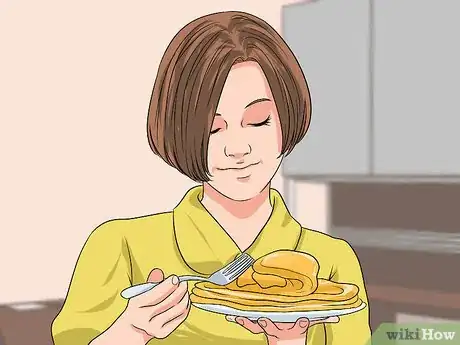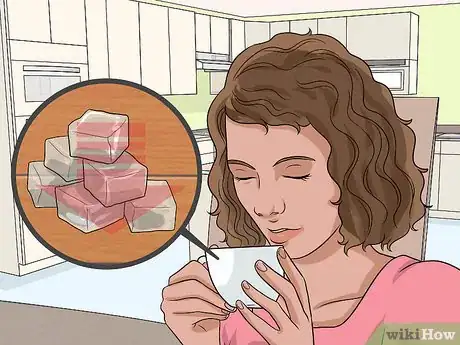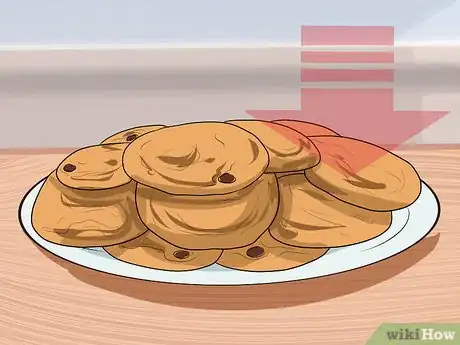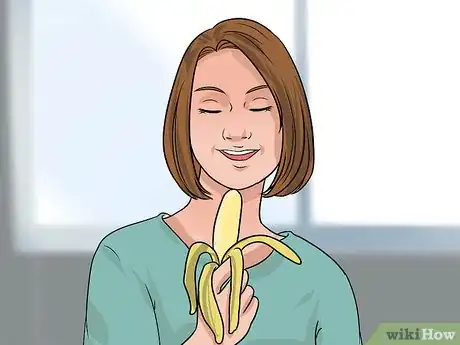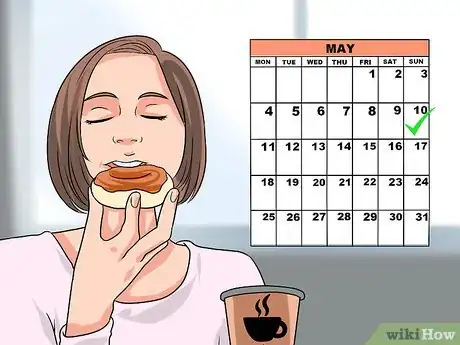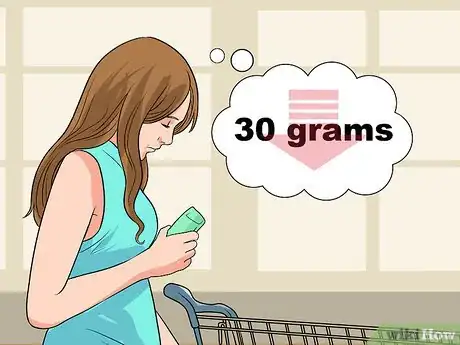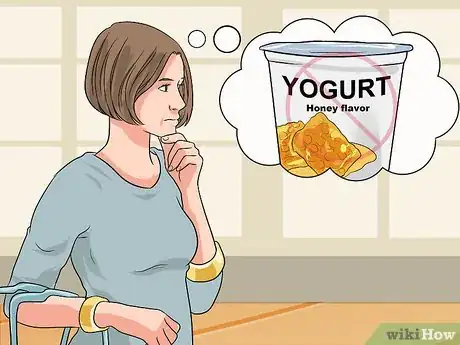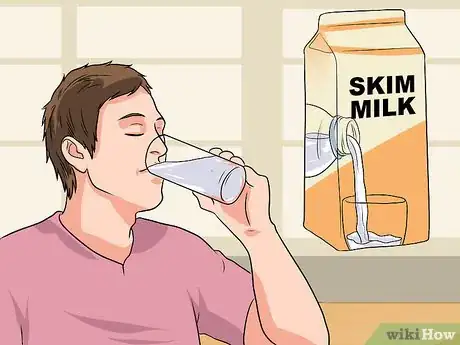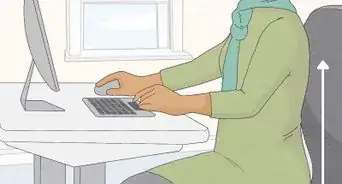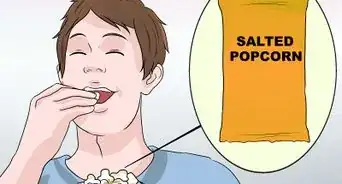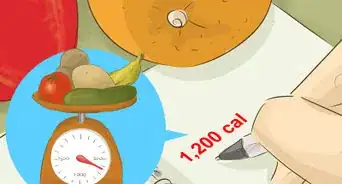This article was co-authored by Tara Coleman. Tara Coleman is a Clinical Nutritionist who has a private practice in San Diego, California. With over 15 years of experience, Tara specializes in sports nutrition, body confidence, and immune system health and offers personalized nutrition, corporate wellness, and online learning courses. She received a BS in Biology from James Madison University and spent six years in the pharmaceutical industry as an analytical chemist before founding her practice. Tara has been featured on NBC, CBS, Fox, ESPN, and Dr. Oz The Good Life as well as in Forbes, Cosmopolitan, Self, and Runner’s World.
There are 8 references cited in this article, which can be found at the bottom of the page.
This article has been viewed 66,380 times.
Sweets can be a tasty treat to reward yourself after a long day. However, many people have trouble consuming sweets in moderation. If you find yourself going overboard on sugary snacks, there are many things you can do to curb your cravings. Try changing your eating habits by removing sugary meals and snacks from your diet. Work on indulging cravings with healthy alternatives, like fruit. When you shop, be on the lookout for sugar. Foods you would not expect, like pasta sauces and breads, are often loaded with added sugars.
Steps
Changing Your Eating Habits
-
1Cut sweet meals from your regular routine. Go over your regular meal routine. Be on the lookout for sweet foods you tend to consume. If you regularly have meals based around sweet goods, look at ways you can avoid those meals.
- Think about what you eat on a regular basis. Maybe a lot of your dishes and side dishes tend to be sweet in nature. Do you, say, eat pancakes or a muffin for breakfast a lot? Do you tend to eat things like candied sweet potatoes or sweetened baked beans during dinner?
- It can be hard to quit cold turkey. You can start by cutting out one sweet meal a week. For example, on Monday mornings, have unsweetened yogurt and fruit for breakfast instead of a muffin. As the weeks go on, you can increase the number of meals you cut.
-
2Alter small sources of sweets in your diet. In addition to sweetened meals, you may consume small amounts of sweets throughout the day. Work on being conscious of the sweets you're consuming, and try to find ways to alter or avoid tiny sources of sweet food.
- Think about tiny sources of sugar you consume. Do you put sugar in your morning coffee? Do you reward yourself with a cookie after a long day at work? Do you tend to mindlessly snack on sugary cereals when bored?
- Look for healthier alternatives. Try drinking coffee black, or adding low sugar sweeteners. Reward yourself with something that's not related to food, like watching an episode of a TV show you like. Replace sugary snacks with healthy snacks, like nuts and dried fruit.
Advertisement -
3Limit sweets in your home. If you keep a lot of sweet food on hand, you're more likely to consume sweets throughout the day. Avoid purchasing food you know you'll snack on excessively.[1] [2]
- Don't bring sugary snacks into your home. If you do have a few sugary snacks on hand, try to go for something like a 100-calorie pack of cookies instead of a whole box.
- Keep sugary foods out of reach. If you have to get on a stepping stool to access a box of cookies, you may be less likely to snack on them.
-
4Manage your eating at celebrations and parties. Social gatherings may be a major source of unhealthy eating. Work on ways to avoid overdoing it when attending parties or going out with friends.
- You'll be less likely to overeat if you feel full before going out. Eat a healthy meal to fill up prior to a social engagement.
- Bring something healthy to snack on at the party. You could, for example, show up with a fruit or veggie platter.
- If you're really craving sugar, have a small piece of something. You could take a single cookie or piece of candy. You could have half a slice of cake instead of a whole slice.
-
5Cut back on soda and alcoholic beverages. Soda can be a major source of sweets in the diet, and alcoholic drinks often include soda as a mixer. If you tend to drink a lot of soda, find ways to cut back. Instead of sugary soda, opt for diet varieties. You can also try going for something like flavored seltzer water to satisfy your craving for something sweet and carbonated.[3]
- To replace soda in mixed drinks, try opting for a drink mixed with plain seltzer or order a glass of dry red or white wine instead.
Managing Cravings
-
1Recognize that sugar is addictive. Sugar is addictive and your desire to eat sweets is a result of your brain’s wiring. It is not a character defect or a sign that you are weak. Try to remind yourself of this when you have a craving. Do not beat yourself up for having a sugar craving.
- The next time you have a craving, try telling yourself something like, “I am craving sugar because of my brain’s wiring. I am not a weak person for craving sugar."
-
2Keep your blood sugar levels stable.[4] Ensuring that your blood sugar levels are stable is a good way to prevent sugar cravings. You can do this by ensuring that you eat regular meals and snacks throughout the day. It is also important to eat foods that your body will metabolize slowly, such as complex carbohydrates and proteins.[5]
- Try having a meal or snack once every three hours to help keep your blood sugar levels stable. Focus on eating foods that will help to stabilize your blood sugar, such as fruits, vegetables, and whole grains.[6]
-
3Indulge cravings with fruit. If you need something sweet, eat some fruits like peaches, apples or bananas. You can also tried frozen fruits or dried fruits. This is a healthy way to satisfy cravings without adding a lot of excess sugar to your diet.[7]
- You can also add fruit to foods you would normally sweeten with sugar. For example, top oatmeal and cereal with fruit.
-
4Add extracts over sugar in recipes. Something like vanilla extract, citrus extract, or almond extract can be added to a recipe in place of sugar. This can sweeten a dish, satisfying your sweet tooth, without adding an onslaught of added table sugar.[8]
- You can also enhance food with spices over sugar. Try nutmeg, cinnamon, ginger, or allspice instead of sugar.
-
5Try artificial sweeteners. Artificial sweeteners do not contain added sugar. You can use them in baked goods, or add them to food and drinks you would normally sweeten with sugar.[9]
- Artificial sweeteners can be purchased at a local grocery store. They include things like stevia and xylitol.
- While more research is needed, some studies do indicate there may be a correlation between artificial sweeteners and weight gain. You may want to stick to artificially sweetened products as an occasional treat rather than making them a staple of your diet.[10]
-
6Avoid snacking when bored. Many people head for the fridge when they are bored. You may mindlessly snack on sweets during dull moments in your day. Instead of loading up on empty calories when bored, find other ways to entertain yourself.[11]
- If you're feeling bored, try learning something new. You could read a book or take up a new hobby.
- You could also do something physical. Try going for a walk or run or playing sports with a friend.
-
7Treat yourself on occasion. Cutting out sweets entirely can be difficult for a variety of reasons. At social get togethers, there will frequently be baked goods. It's also difficult to entirely eliminate sweets, especially if they're something you enjoy. Instead of abandoning sweets completely, try treating yourself on special occasions.
- Many people find they benefit from incorporating a weekly "cheat day" in which they allow themselves to indulge in an otherwise forbidden item. You could, for example, have a donut with your coffee every Sunday morning.
Making Wise Shopping Decisions
-
1Read food labels. It's vital to read food labels when you shop. Many foods that seem healthy are actually loaded with extra sugar. Cutting back on baked goods and sweets may not limit your sugar intake as much as you would think.
- You may be surprised at the amount of added sugar in unexpected products. There may be sugar in things like bread and pasta sauce.
- Before purchasing an item, always read the label. A healthy adult should not eat more than 30 grams, or 7 teaspoons of sugar, each day.[12]
-
2Recognize the various names of sugar. Sugar is not always referred to as sugar on the ingredients list. Sugar is often obscured as companies will list it as something else. Scan the ingredients list and be on the lookout for the following sugar aliases:[13]
- Words that end in "-ose" are often just sugar. Be on the lookout for words like glucose, sucrose, and maltose.
- A product may also contain ingredients that contain a high amount of sugar. Avoid buying products that contain honey, maple syrup, molasses, hydrolyzed starch, corn syrup, coconut palm sugar, and agave nectar.
-
3Look for alternatives to sweets. If you have a sweet tooth, buy alternatives to sweets at your local grocery store. Be on the lookout for products that can satisfy your cravings without adding a lot of extra sugar to your diet.[14]
- Milk tends to contain a lot of sugar. If you enjoy milk, try skim milk over regular varieties. This contains less sugar.
- Watch out for high sugar beverages. Juice tends to contain a lot of added sugar. Look for juice without added sugar or opt for an orange over a glass of orange juice in the morning.
-
4Make healthier baked goods at home. Stop buying sugary baked goods at the grocery store. You can actually cut back on the amount of sugar in a baked good recipe without noticing too much. For example, try add about one-half or one-third of the regular amount of sugar. This will lessen the amount of sugar you consume without affecting your baked goods too much.[15] [16]
Expert Q&A
Did you know you can get expert answers for this article?
Unlock expert answers by supporting wikiHow
-
QuestionWhat can I do to stop my craving for sweets?
 Lyssandra GuerraLyssandra Guerra is a Certified Nutrition & Wellness Consultant and the Founder of Native Palms Nutrition based in Oakland, California. She has over five years of nutrition coaching experience and specializes in providing support to overcome digestive issues, food sensitivities, sugar cravings, and other related dilemmas. She received her holistic nutrition certification from the Bauman College: Holistic Nutrition and Culinary Arts in 2014.
Lyssandra GuerraLyssandra Guerra is a Certified Nutrition & Wellness Consultant and the Founder of Native Palms Nutrition based in Oakland, California. She has over five years of nutrition coaching experience and specializes in providing support to overcome digestive issues, food sensitivities, sugar cravings, and other related dilemmas. She received her holistic nutrition certification from the Bauman College: Holistic Nutrition and Culinary Arts in 2014.
Certified Nutrition & Wellness Consultant
-
QuestionIs there a good alternative, healthy treat if my child has a sweet tooth?
 Lyssandra GuerraLyssandra Guerra is a Certified Nutrition & Wellness Consultant and the Founder of Native Palms Nutrition based in Oakland, California. She has over five years of nutrition coaching experience and specializes in providing support to overcome digestive issues, food sensitivities, sugar cravings, and other related dilemmas. She received her holistic nutrition certification from the Bauman College: Holistic Nutrition and Culinary Arts in 2014.
Lyssandra GuerraLyssandra Guerra is a Certified Nutrition & Wellness Consultant and the Founder of Native Palms Nutrition based in Oakland, California. She has over five years of nutrition coaching experience and specializes in providing support to overcome digestive issues, food sensitivities, sugar cravings, and other related dilemmas. She received her holistic nutrition certification from the Bauman College: Holistic Nutrition and Culinary Arts in 2014.
Certified Nutrition & Wellness Consultant
-
QuestionHow do I stop craving sugar?
 Lyssandra GuerraLyssandra Guerra is a Certified Nutrition & Wellness Consultant and the Founder of Native Palms Nutrition based in Oakland, California. She has over five years of nutrition coaching experience and specializes in providing support to overcome digestive issues, food sensitivities, sugar cravings, and other related dilemmas. She received her holistic nutrition certification from the Bauman College: Holistic Nutrition and Culinary Arts in 2014.
Lyssandra GuerraLyssandra Guerra is a Certified Nutrition & Wellness Consultant and the Founder of Native Palms Nutrition based in Oakland, California. She has over five years of nutrition coaching experience and specializes in providing support to overcome digestive issues, food sensitivities, sugar cravings, and other related dilemmas. She received her holistic nutrition certification from the Bauman College: Holistic Nutrition and Culinary Arts in 2014.
Certified Nutrition & Wellness Consultant
References
- ↑ http://www.mayoclinic.org/healthy-lifestyle/weight-loss/in-depth/weight-loss/art-20047342?pg=2
- ↑ http://www.prevention.com/food/how-cut-down-sugar
- ↑ http://www.heart.org/HEARTORG/HealthyLiving/HealthyEating/Nutrition/Tips-for-Cutting-Down-on-Sugar_UCM_461811_Article.jsp#.V7NJvT4rJPM
- ↑ Tara Coleman. Clinical Nutritionist. Expert Interview. 22 October 2020.
- ↑ Tara Coleman. Clinical Nutritionist. Expert Interview. 22 October 2020.
- ↑ http://www.mayoclinic.org/diseases-conditions/type-2-diabetes/diagnosis-treatment/treatment/txc-20169988
- ↑ http://www.heart.org/HEARTORG/HealthyLiving/HealthyEating/Nutrition/Tips-for-Cutting-Down-on-Sugar_UCM_461811_Article.jsp#.V7NJvT4rJPM
- ↑ http://www.heart.org/HEARTORG/HealthyLiving/HealthyEating/Nutrition/Tips-for-Cutting-Down-on-Sugar_UCM_461811_Article.jsp#.V7NJvT4rJPM
- ↑ http://www.nhs.uk/Livewell/Goodfood/Pages/How-I-reduced-my-sugar-intake.aspx
- ↑ https://www.hsph.harvard.edu/nutritionsource/healthy-drinks/artificial-sweeteners/
- ↑ http://www.mayoclinic.org/healthy-lifestyle/weight-loss/in-depth/weight-loss/art-20047342?pg=2
- ↑ https://www.diabetes.org.uk/Guide-to-diabetes/Enjoy-food/Carbohydrates-and-diabetes/how-to-cut-down-on-sugar/
- ↑ https://www.diabetes.org.uk/Guide-to-diabetes/Enjoy-food/Carbohydrates-and-diabetes/how-to-cut-down-on-sugar/
- ↑ https://www.diabetes.org.uk/Guide-to-diabetes/Enjoy-food/Carbohydrates-and-diabetes/how-to-cut-down-on-sugar/
- ↑ http://www.prevention.com/food/how-cut-down-sugar
- ↑ http://www.heart.org/HEARTORG/HealthyLiving/HealthyEating/Nutrition/Tips-for-Cutting-Down-on-Sugar_UCM_461811_Article.jsp#.V7NJvT4rJPM
- ↑ Tara Coleman. Clinical Nutritionist. Expert Interview. 22 October 2020.
